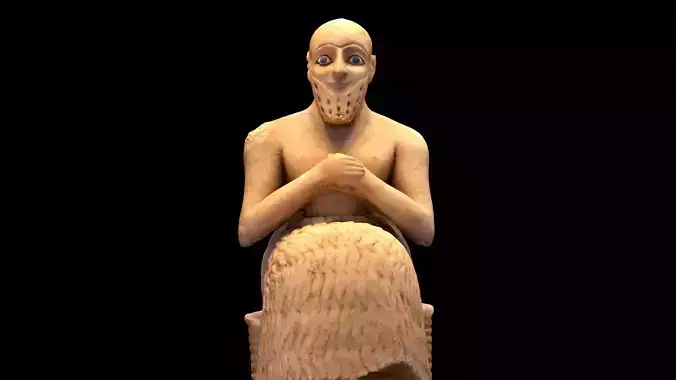1/33
Description of the statue
Detail of the head and bustThe statue, 53 centimetres high, was sculpted from a single block of very fine-grained alabaster. The almond-shaped eyes are inlaid in shell with lapis lazuli irises, precious materials imported from the Persian Gulf and Afghanistan respectively. The eyes and eyebrows are marked with bitumen, traces of which are also found in the locks of the beard.
The statue shows a bearded man with a shaved head, as was the fashion for Mari dignitaries. The eyebrows, known as fishbones, are joined in the middle. He sits on a seat made of sewn reeds - the statue was found with legs that were removed in the 1950s. The bust is naked and slightly slimmed at the waist. The figure wears a long woven kaunakes (skirt), probably a sheepskin , held at the waist by a belt tied at the lower back. His hands are brought to his chest, the right hand resting on the closed left hand. A non-epigraphic incision, but resembling the cuneiform sign kúr, marks the place of the navel. A five-frame inscription is carved on the back of the right shoulder, the usual location for statues of Mari. The inscription is in cuneiform characters that transcribe a Semitic language, specific to the region of Mari and close to that of Ebla, a contemporary Syrian kingdom. Mari does not belong to the Sumerian world.
The work bears traces of ancient restoration. The legs originally belonged to the same block as the rest of the statue, and had been excavated from the seat; the front of the seat still bears traces of cutting and has no decoration, unlike the back. Unbalanced by the excessive weight of the kaunakes, the statue collapsed on its front and the legs were broken at the ankles. The damaged part was sawn off in antiquity and two cavities were made under the front of the kaunakes, allowing both the insertion of new legs and the lightening of the whole. A deep notch was also made under the front of the seat for a new base.
The statue of Ebih-Il is a votive statue from the Archaic Dynasty III period (2500-2334 BC), discovered in 1934 at the site of Mari in Syria by the French;Representing a dignitary with the title of nu-bandà, generally translated as 'steward' or 'inspector', most likely a high-ranking dignitary, it is considered a masterpiece of Mesopotamian statuary.
DiscoveryThe statue of Ebih-Il was discovered in two pieces by André Parrot's mission to Tell Hariri in Syria: the head was unearthed on 22 January 1934, followed the next day, a few metres away, by the body and another smaller statuette. The site was later identified by André Parrot as the pavement of the southern outer courtyard of a temple at Istar Virile. These are the first major discoveries of the excavations, started in winter 1933 after a chance discovery by Bedouins in August. The two statuettes bear inscriptions that identify them: the smaller one is that of Išgi-Mari (first read Lamgi-Mari), king of Mari, and the larger one is that of Ebih-Il (first read Entil) whose title is then interpreted as steward. Both of them dedicated their statue to virile Ištar. The temple of Ishtar-Ush, or Ishtar Virile, has more recently been re-evaluated in its topography, stratigraphy and its place in the religious life of the Euphrates city. The space from which the Ebih-Il statue originates has thus been reinterpreted following the analysis of all the documentation. It is no longer considered as a courtyard south of the temple but as a space outside the temple, adjacent to the road leading from the western gate of the city to the royal palace.
REVIEWS & COMMENTS
accuracy, and usability.

































